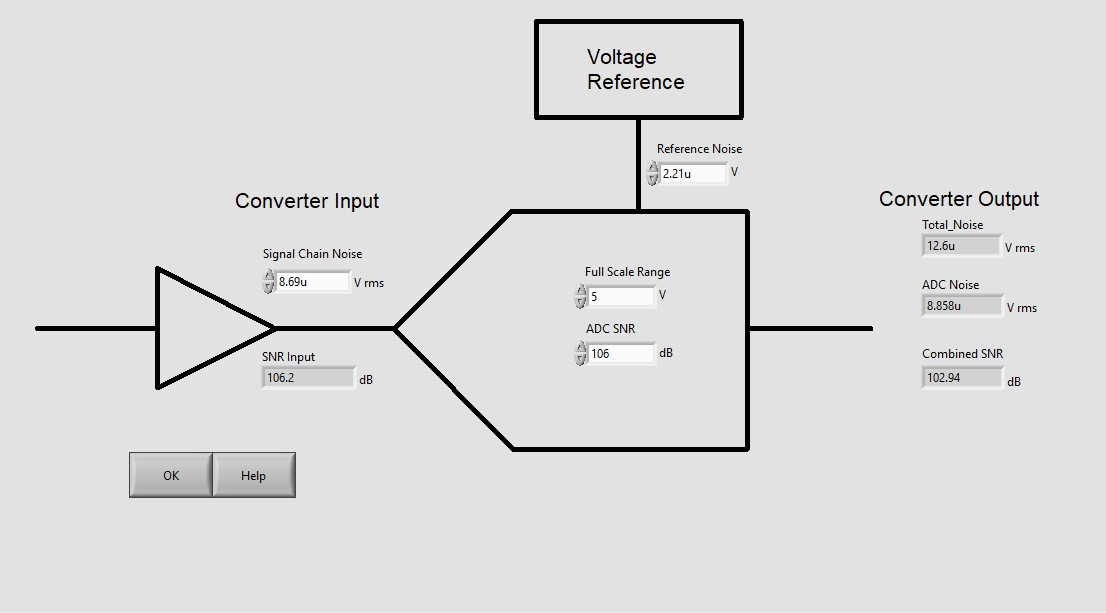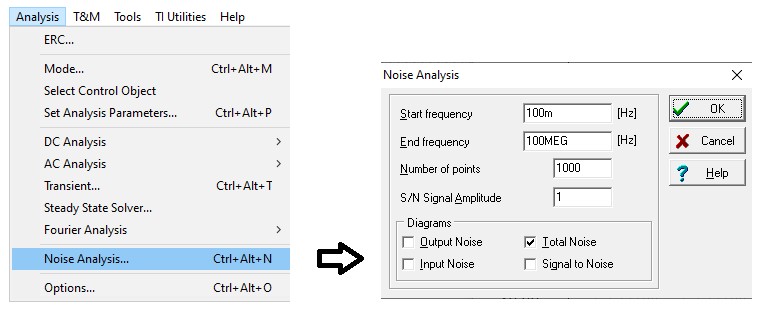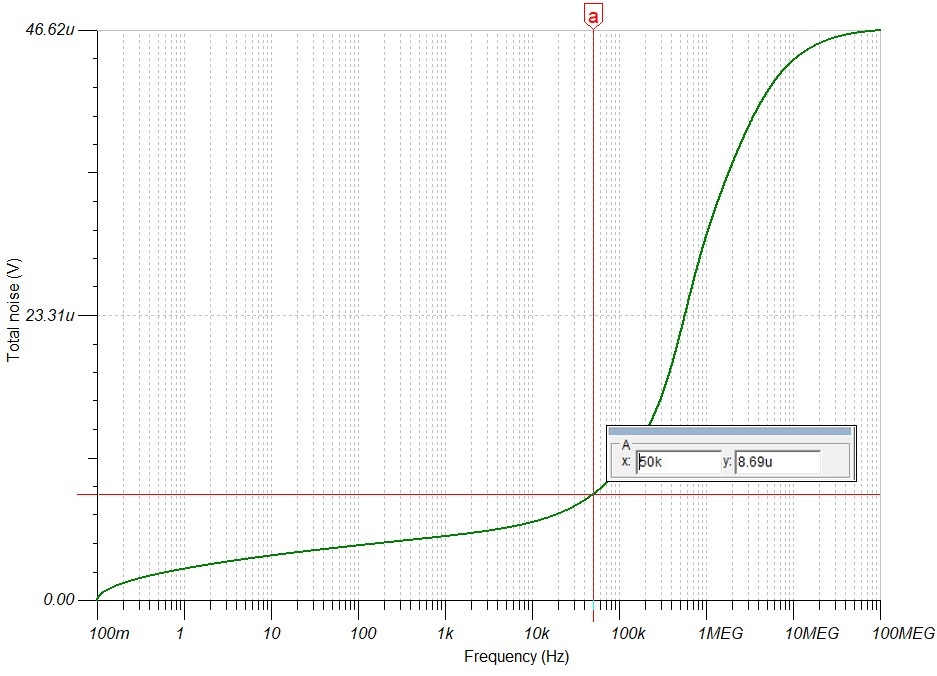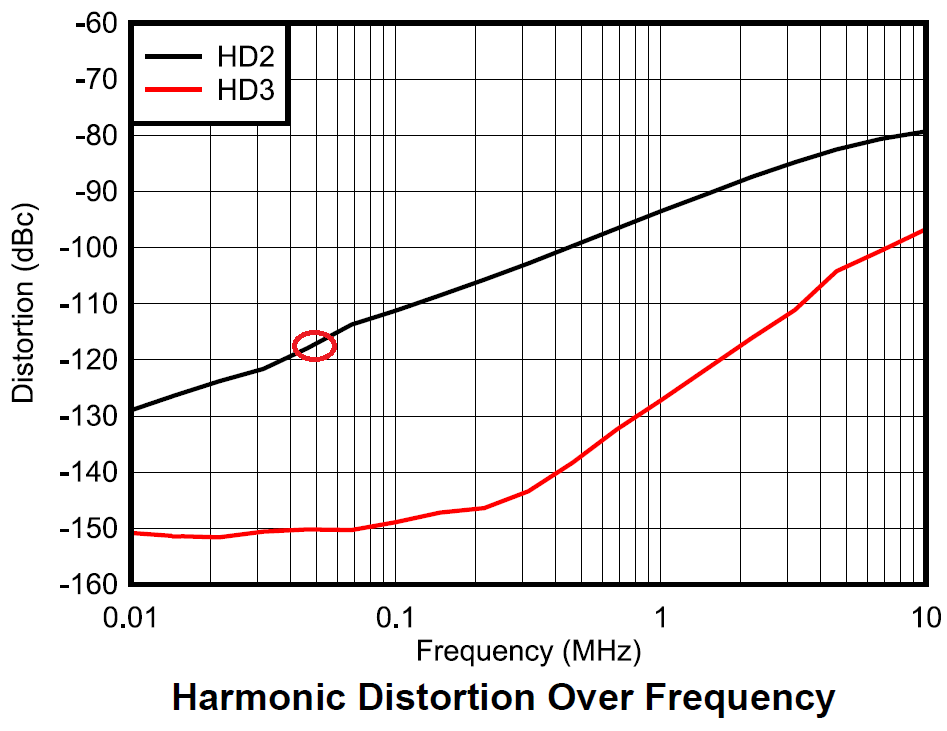SBAA534 March 2022 ADC128S102-SEP , ADC128S102QML-SP , ADS1278-SP , ADS1282-SP , LF411QML-SP , LM101AQML-SP , LM111QML-SP , LM119QML-SP , LM124-SP , LM124AQML-SP , LM136A-2.5QML-SP , LM139-SP , LM139AQML-SP , LM148JAN-SP , LM158QML-SP , LM185-1.2QML-SP , LM185-2.5QML-SP , LM193QML-SP , LM4050QML-SP , LM6172QML-SP , LM7171QML-SP , LMH5401-SP , LMH5485-SEP , LMH5485-SP , LMH6628QML-SP , LMH6702QML-SP , LMH6715QML-SP , LMP2012QML-SP , LMP7704-SP , OPA4277-SP , OPA4H014-SEP , OPA4H199-SEP , THS4304-SP , THS4511-SP , THS4513-SP , TL1431-DIE , TL1431-SP , TLC2201-SP , TLV1704-SEP
2.2 Analysis of Total Noise
To accomplish 16 ENOBs it is fundamental that the signal is significantly stronger than the noise floor of the AFE system. In other words, the SNR value must be high enough.
The ANALOG-ENGINEER’S CALCULATOR provides an easy way to determine the total SNR of the AFE system. Using the ANALOG-ENGINEER’S CALCULATOR, Figure 2-4 illustrates the selection of ADC + Signal Chain Noise from the Data Converters menu.
 Figure 2-4 ‘ADC + Signal Chain Noise’
Analysis in ANALOG-ENGINEER’S CALCULATOR
Figure 2-4 ‘ADC + Signal Chain Noise’
Analysis in ANALOG-ENGINEER’S CALCULATORThe Full Range Scale is 5 V and the ADC SNR value is read from the ADS1278-SP Radiation Hardened 8-Ch Simultaneous-Sampling 24-Bit Analog-to-Digital Converter data sheet. The value for the Signal Chain Noise at the converter input requires a bit more effort. Use the TINA-TI simulator to analyze the schematic from Figure 2-1 for its total noise, reference Figure 2-5 and Figure 2-6.
 Figure 2-5 Select ‘Noise Analysis’ and
Check ‘Total Noise’ in Tina-TI Simulator
Figure 2-5 Select ‘Noise Analysis’ and
Check ‘Total Noise’ in Tina-TI Simulator Figure 2-6 Total Noise Result of the
Analog Input Circuit to the ADC
Figure 2-6 Total Noise Result of the
Analog Input Circuit to the ADCAt 50 kHz - the highest frequency of interest with margin – TINA-TI returns 8.69 μV which can be entered into the ANALOG-ENGINEER’S CALCULATOR as shown in Figure 2-4.
The noise level for the voltage reference can be identified in a similar way with TINA-TI or simply read from the data sheet if just a regular shunt voltage reference device is used. For demonstration purposes, "2.21u" (2.21 μV) is chosen. After selecting the OK button, the tool returns 102.94 dB for the combined SNR.
Applying the standard conversion formula ENOB = (SNR – 1.76) / 6.02 dB, this calculates to ENOB = 16.81 bits.
The Harmonic Distortion Over Frequency graph, Figure 2-7, from the LMH5485-SP data sheet shows distortion of –118 dBc for 50 kHz and below. Its absolute value of 118 dB is significantly enough higher than the previously-identified combined SNR of 102.94 dB. Distortion from non-linearity can therefore be ignored.
 Figure 2-7 LMH5485-SP Data Sheet Shows
THD of About –118 dBc for f = 50 kHz in its Harmonic Distortion Over Frequency
Chart
Figure 2-7 LMH5485-SP Data Sheet Shows
THD of About –118 dBc for f = 50 kHz in its Harmonic Distortion Over Frequency
Chart